#websocket connection
Explore tagged Tumblr posts
Text
Leveraging WebSocket Protocol for Dynamic Online Gaming Experiences
Experience the future of online gaming through the lens of WebSocket technology. Our infographic delves into the dynamic landscape of real-time gaming experiences, fueled by the efficiency and reliability of WebSocket connection.
#real time applications#client server communication#websocket connection#websocket protocol#network configuration#online gaming
0 notes
Text
* These are simple games because I also want to flesh out single packet protocols and implement our first one GYGO (get your game on) which as you can probably ascertain is a single packet protocol for very simple games
28 notes
·
View notes
Text
Introduction to SkillonIT Learning Hub- Empowering Rural Talent With World-Class IT Skills
SkillonIT provides IN-Demand IT courses, connecting Rural talent with rewarding IT skills through affordable, accessible and career-focused education. with Guaranteed pathways to internship and high paying jobs, start with us and step into Opportunities at top Tech-leading Companies. Skillonit Learning Hub, located in Buldhana, Maharashtra, is a leading institute dedicated to equipping individuals with cutting-edge technology skills. With a mission to bridge the digital divide, the institute provides high-quality education in various IT and professional development domains. Skillonit focuses on practical, industry-oriented training, ensuring students gain the expertise needed to thrive in today’s competitive job market. The hub is committed to empowering rural talent and shaping the next generation of skilled professionals.

Courses Offered Skillonit Learning Hub offers a diverse range of courses tailored to industry demands, enabling students to master both technical and professional skills.
Blockchain Development — Smart Contracts (Solidity, Rust, Web3.js, Hardhat) — Blockchain Protocols (Ethereum, Solana, Binance Smart Chain, Fantom) — Decentralized Applications (DApps) Development
Front-End Development — HTML, CSS, JavaScript — Frameworks: React.js, Vue.js, Angular — Responsive Web Design & UI Frameworks (Bootstrap, Tailwind CSS)
Back-End Development — Server-side Programming (Node.js, Python, PHP, Java, .NET) — Database Management (MySQL, MongoDB, Firebase, PostgreSQL) — API Development (RESTful APIs, GraphQL, WebSockets)
Full-Stack Development — Front-End + Back-End Integration — MERN Stack Development — Database, Deployment & DevOps Practice
Mobile App Development — Cross-Platform Development (Flutter, React Native)
Unity 3D Game Development — Game Mechanics & Physics — C# Programming for Game Development — Virtual Reality (VR) & Augmented Reality (AR) Integration
Professional UI/UX Design — User Interface Design (Adobe XD, Figma, Sketch) — User Experience Principles — Prototyping, Wireframing & Usability Testing
Professional Graphic Design — Adobe Photoshop, Illustrator, and CorelDraw — Branding & Logo Design — Digital Art & Visual Communication
Digital Marketing — SEO, SEM, and Social Media Marketing — Content Marketing & Copywriting — Google Ads, Facebook Ads & Analytics
Spoken English — Communication Skills & Public Speaking — Accent Training & Fluency Improvement
Personality Development — Business & Corporate Etiquette — Confidence Building & Interview Preparation — Leadership & Teamwork Skills
Location & Contact : Address : Chhatrapati Tower, Above Maratha Mahila Urban, 3rd Floor, Chikhali Road, Buldhana, Maharashtra, 443001.
Contact us
Conclusion : Skillonit Learning Hub is revolutionizing IT and professional education by making technology and essential career skills accessible to aspiring developers, designers, marketers, and professionals. With a strong emphasis on practical learning, industry exposure, and career opportunities, it stands as a beacon of growth for young talent in Buldhana and beyond. Whether you are looking to build a career in tech, marketing, design, or personal development, Skillonit provides the ideal platform to achieve your goals. Join Our Social Community
Skillonit #Education #ITCourses #Buldhana #Maharashtra #IT #Blockchain #Fullstack #Front-end #Back-end #MobileApp #Unity3d #UIUX #Graphicdesign #Digitalmarketing #SpokenEnglish #Personality #development
2 notes
·
View notes
Text

Crypto Exchange API Integration: Simplifying and Enhancing Trading Efficiency
The cryptocurrency trading landscape is fast-paced, requiring seamless processes and real-time data access to ensure traders stay ahead of market movements. To meet these demands, Crypto Exchange APIs (Application Programming Interfaces) have emerged as indispensable tools for developers and businesses, streamlining trading processes and improving user experience.
APIs bridge the gap between users, trading platforms, and blockchain networks, enabling efficient operations like order execution, wallet integration, and market data retrieval. This blog dives into the importance of crypto exchange API integration, its benefits, and how businesses can leverage it to create feature-rich trading platforms.
What is a Crypto Exchange API?
A Crypto Exchange API is a software interface that enables seamless communication between cryptocurrency trading platforms and external applications. It provides developers with access to various functionalities, such as real-time price tracking, trade execution, and account management, allowing them to integrate these features into their platforms.
Types of Crypto Exchange APIs:
REST APIs: Used for simple, one-time data requests (e.g., fetching market data or placing a trade).
WebSocket APIs: Provide real-time data streaming for high-frequency trading and live updates.
FIX APIs (Financial Information Exchange): Designed for institutional-grade trading with high-speed data transfers.
Key Benefits of Crypto Exchange API Integration
1. Real-Time Market Data Access
APIs provide up-to-the-second updates on cryptocurrency prices, trading volumes, and order book depth, empowering traders to make informed decisions.
Use Case:
Developers can build dashboards that display live market trends and price movements.
2. Automated Trading
APIs enable algorithmic trading by allowing users to execute buy and sell orders based on predefined conditions.
Use Case:
A trading bot can automatically place orders when specific market criteria are met, eliminating the need for manual intervention.
3. Multi-Exchange Connectivity
Crypto APIs allow platforms to connect with multiple exchanges, aggregating liquidity and providing users with the best trading options.
Use Case:
Traders can access a broader range of cryptocurrencies and trading pairs without switching between platforms.
4. Enhanced User Experience
By integrating APIs, businesses can offer features like secure wallet connections, fast transaction processing, and detailed analytics, improving the overall user experience.
Use Case:
Users can track their portfolio performance in real-time and manage assets directly through the platform.
5. Increased Scalability
API integration allows trading platforms to handle a higher volume of users and transactions efficiently, ensuring smooth operations during peak trading hours.
Use Case:
Exchanges can scale seamlessly to accommodate growth in user demand.
Essential Features of Crypto Exchange API Integration
1. Trading Functionality
APIs must support core trading actions, such as placing market and limit orders, canceling trades, and retrieving order statuses.
2. Wallet Integration
Securely connect wallets for seamless deposits, withdrawals, and balance tracking.
3. Market Data Access
Provide real-time updates on cryptocurrency prices, trading volumes, and historical data for analysis.
4. Account Management
Allow users to manage their accounts, view transaction history, and set preferences through the API.
5. Security Features
Integrate encryption, two-factor authentication (2FA), and API keys to safeguard user data and funds.
Steps to Integrate Crypto Exchange APIs
1. Define Your Requirements
Determine the functionalities you need, such as trading, wallet integration, or market data retrieval.
2. Choose the Right API Provider
Select a provider that aligns with your platform’s requirements. Popular providers include:
Binance API: Known for real-time data and extensive trading options.
Coinbase API: Ideal for wallet integration and payment processing.
Kraken API: Offers advanced trading tools for institutional users.
3. Implement API Integration
Use REST APIs for basic functionalities like fetching market data.
Implement WebSocket APIs for real-time updates and faster trading processes.
4. Test and Optimize
Conduct thorough testing to ensure the API integration performs seamlessly under different scenarios, including high traffic.
5. Launch and Monitor
Deploy the integrated platform and monitor its performance to address any issues promptly.
Challenges in Crypto Exchange API Integration
1. Security Risks
APIs are vulnerable to breaches if not properly secured. Implement robust encryption, authentication, and monitoring tools to mitigate risks.
2. Latency Issues
High latency can disrupt real-time trading. Opt for APIs with low latency to ensure a smooth user experience.
3. Regulatory Compliance
Ensure the integration adheres to KYC (Know Your Customer) and AML (Anti-Money Laundering) regulations.
The Role of Crypto Exchange Platform Development Services
Partnering with a professional crypto exchange platform development service ensures your platform leverages the full potential of API integration.
What Development Services Offer:
Custom API Solutions: Tailored to your platform’s specific needs.
Enhanced Security: Implementing advanced security measures like API key management and encryption.
Real-Time Capabilities: Optimizing APIs for high-speed data transfers and trading.
Regulatory Compliance: Ensuring the platform meets global legal standards.
Scalability: Building infrastructure that grows with your user base and transaction volume.
Real-World Examples of Successful API Integration
1. Binance
Features: Offers REST and WebSocket APIs for real-time market data and trading.
Impact: Enables developers to build high-performance trading bots and analytics tools.
2. Coinbase
Features: Provides secure wallet management APIs and payment processing tools.
Impact: Streamlines crypto payments and wallet integration for businesses.
3. Kraken
Features: Advanced trading APIs for institutional and professional traders.
Impact: Supports multi-currency trading with low-latency data feeds.
Conclusion
Crypto exchange API integration is a game-changer for businesses looking to streamline trading processes and enhance user experience. From enabling real-time data access to automating trades and managing wallets, APIs unlock endless possibilities for innovation in cryptocurrency trading platforms.
By partnering with expert crypto exchange platform development services, you can ensure secure, scalable, and efficient API integration tailored to your platform’s needs. In the ever-evolving world of cryptocurrency, seamless API integration is not just an advantage—it’s a necessity for staying ahead of the competition.
Are you ready to take your crypto exchange platform to the next level?
#cryptocurrencyexchange#crypto exchange platform development company#crypto exchange development company#white label crypto exchange development#cryptocurrency exchange development service#cryptoexchange
2 notes
·
View notes
Text
Load Balancing Web Sockets with K8s/Istio
When load balancing WebSockets in a Kubernetes (K8s) environment with Istio, there are several considerations to ensure persistent, low-latency connections. WebSockets require special handling because they are long-lived, bidirectional connections, which are different from standard HTTP request-response communication. Here’s a guide to implementing load balancing for WebSockets using Istio.
1. Enable WebSocket Support in Istio
By default, Istio supports WebSocket connections, but certain configurations may need tweaking. You should ensure that:
Destination rules and VirtualServices are configured appropriately to allow WebSocket traffic.
Example VirtualService Configuration.
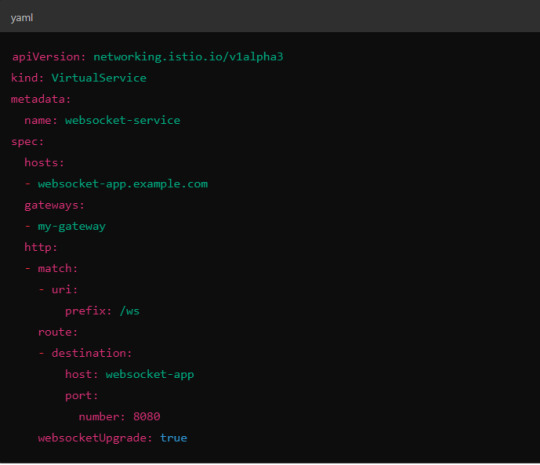
Here, websocketUpgrade: true explicitly allows WebSocket traffic and ensures that Istio won’t downgrade the WebSocket connection to HTTP.
2. Session Affinity (Sticky Sessions)
In WebSocket applications, sticky sessions or session affinity is often necessary to keep long-running WebSocket connections tied to the same backend pod. Without session affinity, WebSocket connections can be terminated if the load balancer routes the traffic to a different pod.
Implementing Session Affinity in Istio.
Session affinity is typically achieved by setting the sessionAffinity field to ClientIP at the Kubernetes service level.
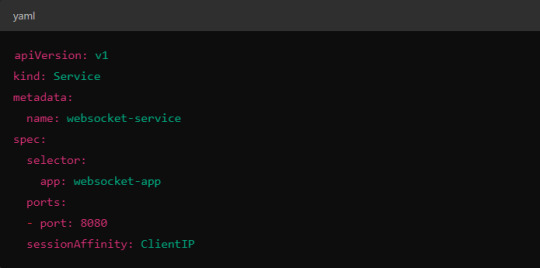
In Istio, you might also control affinity using headers. For example, Istio can route traffic based on headers by configuring a VirtualService to ensure connections stay on the same backend.
3. Load Balancing Strategy
Since WebSocket connections are long-lived, round-robin or random load balancing strategies can lead to unbalanced workloads across pods. To address this, you may consider using least connection or consistent hashing algorithms to ensure that existing connections are efficiently distributed.
Load Balancer Configuration in Istio.
Istio allows you to specify different load balancing strategies in the DestinationRule for your services. For WebSockets, the LEAST_CONN strategy may be more appropriate.
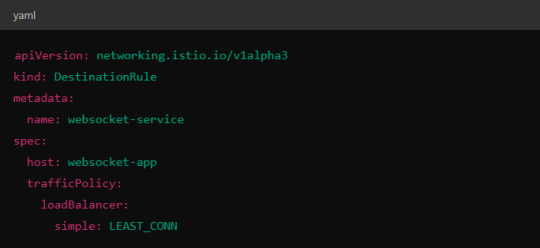
Alternatively, you could use consistent hashing for a more sticky routing based on connection properties like the user session ID.
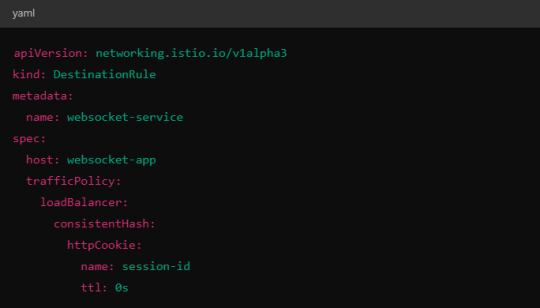
This configuration ensures that connections with the same session ID go to the same pod.
4. Scaling Considerations
WebSocket applications can handle a large number of concurrent connections, so you’ll need to ensure that your Kubernetes cluster can scale appropriately.
Horizontal Pod Autoscaler (HPA): Use an HPA to automatically scale your pods based on metrics like CPU, memory, or custom metrics such as open WebSocket connections.
Istio Autoscaler: You may also scale Istio itself to handle the increased load on the control plane as WebSocket connections increase.
5. Connection Timeouts and Keep-Alive
Ensure that both your WebSocket clients and the Istio proxy (Envoy) are configured for long-lived connections. Some settings that need attention:
Timeouts: In VirtualService, make sure there are no aggressive timeout settings that would prematurely close WebSocket connections.

Keep-Alive Settings: You can also adjust the keep-alive settings at the Envoy level if necessary. Envoy, the proxy used by Istio, supports long-lived WebSocket connections out-of-the-box, but custom keep-alive policies can be configured.
6. Ingress Gateway Configuration
If you're using an Istio Ingress Gateway, ensure that it is configured to handle WebSocket traffic. The gateway should allow for WebSocket connections on the relevant port.
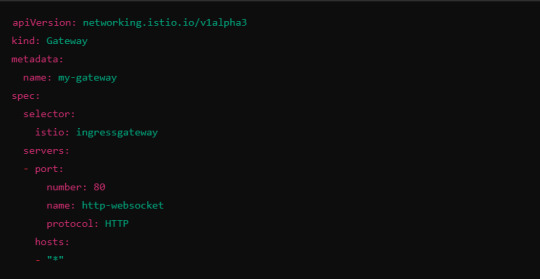
This configuration ensures that the Ingress Gateway can handle WebSocket upgrades and correctly route them to the backend service.
Summary of Key Steps
Enable WebSocket support in Istio’s VirtualService.
Use session affinity to tie WebSocket connections to the same backend pod.
Choose an appropriate load balancing strategy, such as least connection or consistent hashing.
Set timeouts and keep-alive policies to ensure long-lived WebSocket connections.
Configure the Ingress Gateway to handle WebSocket traffic.
By properly configuring Istio, Kubernetes, and your WebSocket service, you can efficiently load balance WebSocket connections in a microservices architecture.
#kubernetes#websockets#Load Balancing#devops#linux#coding#programming#Istio#virtualservices#Load Balancer#Kubernetes cluster#gateway#python#devlog#github#ansible
5 notes
·
View notes
Text
Hey, Tumblr, I'm angry and frustrated and I'm making it your problem.

Break the Keep Reading only if you either A. have any experience with OBS-Websocket or other such integrations, or B. sincerely wish to partake in my suffering. Warning for excessive cursing, it gets rough.
Update on the whole KT-1632 overlay situation: After a handful of minor technical difficulties and rookie mistakes (hey cat, it would help if you actually turned on the damn websocket before trying to connect to it), I've established a base framework for connecting to OBS Websocket.
Once I had that in place, I started testing out what kind of messages I can get, and uh... I'm already running into a huge problem, here.
See, OBS Websocket 5.0 has the following messages that seem pertinent to my use case: CurrentProgramSceneChanged, SceneTransitionStarted, SceneTransitionEnded, and SceneTransitionVideoEnded. Keep in mind, the only documentation I can access right now, as far as I can tell, is just the 5.0.1 OBS-Websocket.
Here's a refresher on the use case: I want to be able to move elements of my Unity-based stream overlay depending on which scene is currently active in OBS. A wrinkle in this is that I use a custom stinger transition with a specific cut point, like this:
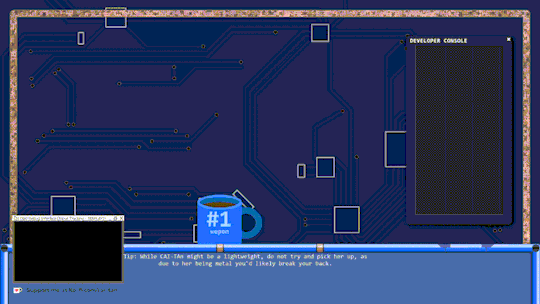
Now, all three events regarding the scene transition only have one piece of data to them: the name of the transition (which is basically always going to be "SniperScope"). The only event that actually tells me what scene is being switched to is the CurrentProgramSceneChanged event.
There is an immediate problem.

Funnily enough, this order of operations is actually backwards from the current documentation:
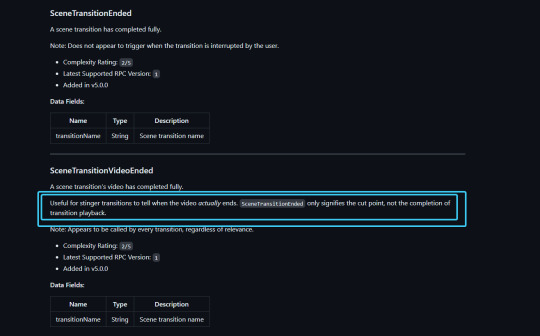
On the one hand, there could potentially be some sort of delay or other issue involved with WebsocketSharp / Unity that's responsible for this, however in my testing the exact amount of delay and order of operations is entirely consistent every single time I initiate a transition in OBS. The first message almost always arrives instantaneously; it's the other three messages that seem to come whenever they feel like it, and not at all close to what they need to be at.
On the other hand-- wait, what? What's this issue on the official obs-websocket github about--
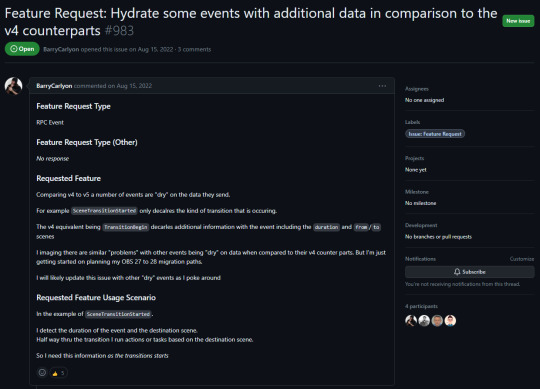
So you're telling me that SceneTransitionStarted used to have the from and to scenes specified in the event data in version 4, and they removed it in version 5 for literally no other reason than an RPC overhaul? And they haven't added it back in OVER A YEAR?!
Now, the github actually does have an install link for obs-websocket version 4.9.1-compat that should (keyword should, you know how that goes) work with OBS 29 (more specifically, it should work with 28+, which means there isn't even a guarantee for it to work with OBS 29... fucking awesome).
However, uhhhhhh... I cannot find ANY FUCKING DOCUMENTATION FOR 4.9'S PROTOCOL WHATSO-FUCKING-EVER. There is LITERALLY ONLY 5.0 in the readmes and protocol.md docs.
This shit has me pulling my hair. I'm goin' the fuck to sleep. Anyone got any bright fuckin ideas, I'm all fuckin' ears for it in the morning.
#pain and suffering#streaming#indie vtuber#software development#obs troubleshooting#obs studio#help appreciated#websocketsharp#obs websocket
3 notes
·
View notes
Text
Advanced Techniques in Full-Stack Development

Certainly, let's delve deeper into more advanced techniques and concepts in full-stack development:
1. Server-Side Rendering (SSR) and Static Site Generation (SSG):
SSR: Rendering web pages on the server side to improve performance and SEO by delivering fully rendered pages to the client.
SSG: Generating static HTML files at build time, enhancing speed, and reducing the server load.
2. WebAssembly:
WebAssembly (Wasm): A binary instruction format for a stack-based virtual machine. It allows high-performance execution of code on web browsers, enabling languages like C, C++, and Rust to run in web applications.
3. Progressive Web Apps (PWAs) Enhancements:
Background Sync: Allowing PWAs to sync data in the background even when the app is closed.
Web Push Notifications: Implementing push notifications to engage users even when they are not actively using the application.
4. State Management:
Redux and MobX: Advanced state management libraries in React applications for managing complex application states efficiently.
Reactive Programming: Utilizing RxJS or other reactive programming libraries to handle asynchronous data streams and events in real-time applications.
5. WebSockets and WebRTC:
WebSockets: Enabling real-time, bidirectional communication between clients and servers for applications requiring constant data updates.
WebRTC: Facilitating real-time communication, such as video chat, directly between web browsers without the need for plugins or additional software.
6. Caching Strategies:
Content Delivery Networks (CDN): Leveraging CDNs to cache and distribute content globally, improving website loading speeds for users worldwide.
Service Workers: Using service workers to cache assets and data, providing offline access and improving performance for returning visitors.
7. GraphQL Subscriptions:
GraphQL Subscriptions: Enabling real-time updates in GraphQL APIs by allowing clients to subscribe to specific events and receive push notifications when data changes.
8. Authentication and Authorization:
OAuth 2.0 and OpenID Connect: Implementing secure authentication and authorization protocols for user login and access control.
JSON Web Tokens (JWT): Utilizing JWTs to securely transmit information between parties, ensuring data integrity and authenticity.
9. Content Management Systems (CMS) Integration:
Headless CMS: Integrating headless CMS like Contentful or Strapi, allowing content creators to manage content independently from the application's front end.
10. Automated Performance Optimization:
Lighthouse and Web Vitals: Utilizing tools like Lighthouse and Google's Web Vitals to measure and optimize web performance, focusing on key user-centric metrics like loading speed and interactivity.
11. Machine Learning and AI Integration:
TensorFlow.js and ONNX.js: Integrating machine learning models directly into web applications for tasks like image recognition, language processing, and recommendation systems.
12. Cross-Platform Development with Electron:
Electron: Building cross-platform desktop applications using web technologies (HTML, CSS, JavaScript), allowing developers to create desktop apps for Windows, macOS, and Linux.
13. Advanced Database Techniques:
Database Sharding: Implementing database sharding techniques to distribute large databases across multiple servers, improving scalability and performance.
Full-Text Search and Indexing: Implementing full-text search capabilities and optimized indexing for efficient searching and data retrieval.
14. Chaos Engineering:
Chaos Engineering: Introducing controlled experiments to identify weaknesses and potential failures in the system, ensuring the application's resilience and reliability.
15. Serverless Architectures with AWS Lambda or Azure Functions:
Serverless Architectures: Building applications as a collection of small, single-purpose functions that run in a serverless environment, providing automatic scaling and cost efficiency.
16. Data Pipelines and ETL (Extract, Transform, Load) Processes:
Data Pipelines: Creating automated data pipelines for processing and transforming large volumes of data, integrating various data sources and ensuring data consistency.
17. Responsive Design and Accessibility:
Responsive Design: Implementing advanced responsive design techniques for seamless user experiences across a variety of devices and screen sizes.
Accessibility: Ensuring web applications are accessible to all users, including those with disabilities, by following WCAG guidelines and ARIA practices.
full stack development training in Pune
2 notes
·
View notes
Text
You can learn NodeJS easily, Here's all you need:
1.Introduction to Node.js
• JavaScript Runtime for Server-Side Development
• Non-Blocking I/0
2.Setting Up Node.js
• Installing Node.js and NPM
• Package.json Configuration
• Node Version Manager (NVM)
3.Node.js Modules
• CommonJS Modules (require, module.exports)
• ES6 Modules (import, export)
• Built-in Modules (e.g., fs, http, events)
4.Core Concepts
• Event Loop
• Callbacks and Asynchronous Programming
• Streams and Buffers
5.Core Modules
• fs (File Svstem)
• http and https (HTTP Modules)
• events (Event Emitter)
• util (Utilities)
• os (Operating System)
• path (Path Module)
6.NPM (Node Package Manager)
• Installing Packages
• Creating and Managing package.json
• Semantic Versioning
• NPM Scripts
7.Asynchronous Programming in Node.js
• Callbacks
• Promises
• Async/Await
• Error-First Callbacks
8.Express.js Framework
• Routing
• Middleware
• Templating Engines (Pug, EJS)
• RESTful APIs
• Error Handling Middleware
9.Working with Databases
• Connecting to Databases (MongoDB, MySQL)
• Mongoose (for MongoDB)
• Sequelize (for MySQL)
• Database Migrations and Seeders
10.Authentication and Authorization
• JSON Web Tokens (JWT)
• Passport.js Middleware
• OAuth and OAuth2
11.Security
• Helmet.js (Security Middleware)
• Input Validation and Sanitization
• Secure Headers
• Cross-Origin Resource Sharing (CORS)
12.Testing and Debugging
• Unit Testing (Mocha, Chai)
• Debugging Tools (Node Inspector)
• Load Testing (Artillery, Apache Bench)
13.API Documentation
• Swagger
• API Blueprint
• Postman Documentation
14.Real-Time Applications
• WebSockets (Socket.io)
• Server-Sent Events (SSE)
• WebRTC for Video Calls
15.Performance Optimization
• Caching Strategies (in-memory, Redis)
• Load Balancing (Nginx, HAProxy)
• Profiling and Optimization Tools (Node Clinic, New Relic)
16.Deployment and Hosting
• Deploying Node.js Apps (PM2, Forever)
• Hosting Platforms (AWS, Heroku, DigitalOcean)
• Continuous Integration and Deployment-(Jenkins, Travis CI)
17.RESTful API Design
• Best Practices
• API Versioning
• HATEOAS (Hypermedia as the Engine-of Application State)
18.Middleware and Custom Modules
• Creating Custom Middleware
• Organizing Code into Modules
• Publish and Use Private NPM Packages
19.Logging
• Winston Logger
• Morgan Middleware
• Log Rotation Strategies
20.Streaming and Buffers
• Readable and Writable Streams
• Buffers
• Transform Streams
21.Error Handling and Monitoring
• Sentry and Error Tracking
• Health Checks and Monitoring Endpoints
22.Microservices Architecture
• Principles of Microservices
• Communication Patterns (REST, gRPC)
• Service Discovery and Load Balancing in Microservices
1 note
·
View note
Text
Redefining Real-Time Applications for Websockets
Gain insights into WebSockets' pivotal role in real-time applications, revolutionizing client-server communication. Delve into WebSocket protocol intricacies and network configuration essentials, crucial for optimizing online gaming experiences.
#real time applications#client server communication#websocket connection#\websocket protocol#network configuration#online gaming
0 notes
Text
The Technology Stack Behind a Fast Cryptocurrency Exchange Script

In the fast-paced world of crypto trading, speed, security, and scalability are everything. Whether you're launching a new platform or upgrading an existing one, the technology stack behind your cryptocurrency exchange script plays a crucial role in user experience and platform success.
Let’s break down what goes into building a lightning-fast and secure crypto exchange.
🔹 Frontend Technologies
Speedy UI/UX is critical. Most modern exchanges use React.js or Vue.js to build interactive, responsive interfaces. These frameworks ensure real-time updates for charts, orders, and wallets without page reloads.
🔹 Backend Frameworks
A high-performance backend is the engine. Node.js, Go, or Python (Django) are popular choices thanks to their scalability and non-blocking architecture. These handle everything from API requests to order matching engines efficiently.
🔹 Database Layer
Handling massive transactional data? Robust databases like PostgreSQL, MongoDB, or Redis are often used for storing trade history, user data, and wallet balances. Some platforms use a hybrid structure to combine speed and consistency.
🔹 Blockchain Integration
A core component of any cryptocurrency exchange script is wallet integration. Secure APIs connect your platform to major blockchains like Bitcoin, Ethereum, BNB Chain, and others for deposits, withdrawals, and transaction tracking.
🔹 Security Stack
Cyber threats are real. A solid exchange script includes 2FA, anti-DDoS protection, KYC/AML modules, and encrypted wallets to ensure compliance and protect user funds.
🔹 Real-Time Engines
For instant order execution and price updates, technologies like WebSockets and Kafka enable real-time data flow, critical for high-frequency traders.
🔹 DevOps & Deployment
Using Docker, Kubernetes, and cloud platforms like AWS or Azure ensures that your exchange is scalable, highly available, and easy to maintain. A solid cryptocurrency exchange script backed by this stack not only performs faster but also earns user trust. Are you using the right stack to build your crypto platform?
0 notes
Text
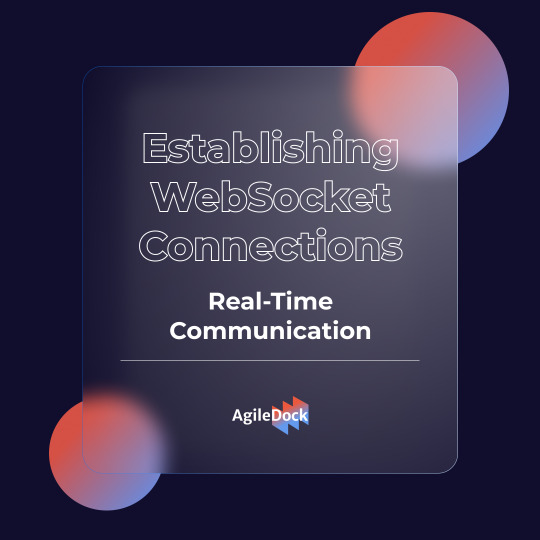
Harnessing Websockets for Real-Time Efficiency
Get an understanding of real-time applications by harnessing the potential of WebSockets. See how Websockets are driving efficiency and interactivity in online gaming and beyond.
#real time applications#client server communication#websocket connection#websocket protocol#network configuration#online gaming
0 notes
Text
Ambulance App Development
Imagine being stuck in traffic with a loved one in need of urgent medical attention. You dial emergency services, but help is delayed. Unfortunately, that scenario is far too common in many parts of the world. Now picture this: with just a few taps on your phone, an ambulance is on its way, with real-time tracking and updates. That’s the magic of Ambulance App Development.
In recent years, mobile technology has completely reshaped how we access healthcare. Much like ride-hailing apps changed the way we book taxis, on-demand ambulance app development is now doing the same for emergency medical services.
Let’s break it down.
What Is an Ambulance App?
An ambulance app is a digital platform that connects users with the nearest available ambulance in real time. It allows for fast booking, live location tracking, medical data sharing, and even direct coordination with hospitals.
You could think of it as an Uber for Ambulance. Just as ride-hailing services made cabs more accessible and efficient, ambulance apps are revolutionizing how emergency care reaches people.
Why Do We Need Ambulance Apps?
Across the globe, the traditional emergency medical system has struggled with delays, miscommunication, and lack of transparency.
Here’s what ambulance apps bring to the table:
Faster response times
Real-time GPS tracking
Digital patient records sharing
Route optimization for drivers
Cashless payments and digital receipts
These features not only help patients but also make operations smoother for healthcare providers and EMT teams.
Real-World Examples
India's Ziqitza Healthcare has been leading the charge in providing on-demand ambulance services in several states through a user-friendly mobile app. In Kenya, Flare offers an Uber-style service for ambulances, connecting users to a network of emergency responders across the country. The UK’s GoodSAM platform integrates with the NHS and uses crowd-sourced first responders to help patients before the ambulance even arrives.
These examples show that on-demand ambulance app development is not a luxury anymore—it’s a necessity.
Key Features of a Successful Ambulance App
Creating an ambulance app isn't just about throwing in a few features. You need a well-thought-out design that considers the needs of both patients and healthcare providers.
Here’s a quick peek at what makes a solid app tick:
1. Instant Booking
Users can book ambulances with a tap and share their live location instantly.
2. Real-Time Tracking
See exactly where your ambulance is and how long it will take to arrive.
3. Multiple Ambulance Types
Let users choose from basic, advanced, ICU-equipped, or neonatal ambulances.
4. Driver & EMT Profiles
Build trust by displaying driver and EMT details with ratings and certifications.
5. Digital Payments
Simplify transactions with integrated payment gateways and insurance options.
6. Emergency Contacts & Medical Info
Allow users to add medical history and emergency contact numbers in advance.
7. Hospital Integration
Hospitals can prepare for the incoming patient, reducing wait time on arrival.
Technology Stack: What’s Under the Hood?
Just like a high-performance car, an ambulance app needs a powerful engine behind it. Here’s what you’ll typically find:
Frontend: React Native or Flutter for cross-platform functionality
Backend: Node.js, Python, or Java with robust APIs
Database: MongoDB, PostgreSQL, or Firebase
GPS & Navigation: Google Maps, Mapbox, or OpenStreetMap
Payment Gateways: Stripe, Razorpay, or PayPal
Real-Time Features: WebSocket or Firebase for live updates
The key to success? Choosing scalable, secure, and fast technologies that ensure zero lag during critical moments.
Business Models for Ambulance Apps
Thinking of investing in ambulance app development? You’ve got options. Here are some popular business models:
Aggregator Model: Like Uber, connect multiple ambulance providers under one platform.
Hospital-Based Model: An internal app exclusively for a hospital’s emergency fleet.
Subscription-Based: Offer premium memberships with priority response and additional features.
Pay-Per-Use: Users pay a one-time fee per emergency trip.
Each model has its pros and cons. Your choice depends on your market, goals, and target audience.
Challenges to Watch Out For
Let’s be real: this isn’t an easy business. Here are some bumps on the road you’ll need to steer around:
Regulatory compliance with healthcare and transport authorities
Ensuring data security, especially with patient medical records
Maintaining a well-trained and verified network of EMTs and drivers
Managing operations during peak demand or natural disasters
With proper planning and the right tech partner, these challenges can absolutely be managed.
Conclusion
In a world where everything is moving faster, healthcare can’t afford to lag behind. Ambulance app development is more than just a tech trend—it’s a life-saving tool that brings emergency services to the fingertips of millions. From reducing response times to helping hospitals better manage patients, these apps are changing the game.
Whether you're a healthcare provider looking to modernize, an entrepreneur exploring med-tech, or a government agency wanting to improve emergency services, now’s the time to take the leap.
Don’t just follow the trend. Be the reason someone gets help when they need it most.
Building an Uber for Ambulance app can be your way of doing just that.
If you’re ready to dive into on-demand ambulance app development, find a tech partner with real healthcare experience, focus on user needs, and never compromise on reliability. Because when it comes to emergencies, there are no second chances.
0 notes
Text
MEV Bot Development: A Step-by-Step Guide

Introduction
As the DeFi ecosystem grows more complex, MEV (Maximal Extractable Value) bots have become one of the most powerful—and controversial—tools in crypto trading. These bots are designed to extract value from blockchain transactions by reordering, inserting, or censoring transactions in a block. While originally focused on miners, today’s MEV bot development company opportunities are accessible to smart developers who can build bots to interact with protocols like Uniswap, SushiSwap, Curve, and others.
In this step-by-step guide, we’ll walk through the process of developing your own MEV bot—from understanding its core components to writing, simulating, and deploying it.
What Is an MEV Bot?
An MEV bot is an automated trading agent that exploits inefficiencies in blockchain transactions. It aims to maximize profit through techniques such as:
Arbitrage: Buying an asset at a lower price on one DEX and selling it higher on another.
Sandwich Attacks: Placing a buy order before and a sell order after a large user transaction to manipulate price movements.
Liquidation Sniping: Monitoring DeFi lending protocols for vulnerable positions and profiting from liquidations.
These bots monitor the mempool or integrate with services like Flashbots to submit private bundles directly to miners or validators.
MEV Bot Development: A Step-by-Step Guide
Step 1: Understand MEV Fundamentals
Start by learning what Maximal Extractable Value (MEV) means, how it impacts Ethereum and other blockchains, and the types of MEV strategies such as arbitrage, sandwich attacks, and liquidations. Understanding blockchain mechanics, mempool structure, transaction ordering, and frontrunning concepts is critical before development.
Step 2: Choose Your MEV Strategy
Select the specific MEV technique you want to implement—DEX arbitrage, sandwiching, liquidation sniping, or time-bandit attacks. Your choice will determine the logic and external data your bot will need to operate effectively.
Step 3: Set Up Your Development Environment
Install essential tools like Node.js, Hardhat or Foundry, ethers.js or web3.js, and connect to Ethereum mainnet via Infura or Alchemy. Set up Flashbots for private transaction bundling. Use Git and VSCode for development and version control.
Step 4: Monitor Blockchain Data and Mempool
Develop or use an existing script to monitor pending transactions in the mempool using WebSocket or JSON-RPC. For strategies like sandwich or liquidation attacks, listen for large swaps or vulnerable loans, and simulate how your bot should respond.
Step 5: Write the Bot Logic
Create the logic for transaction construction, execution flow, and profit calculation. Include logic for gas estimation, token approvals, smart contract calls, and condition-based execution. Integrate error handling and fallback mechanisms.
Step 6: Simulate and Test on a Forked Network
Use Hardhat or Foundry to fork mainnet and simulate your bot’s transactions in a safe environment. Test for profitability, failed conditions, slippage, and gas efficiency. Refine strategy logic based on simulation results.
Step 7: Integrate Flashbots for Private Execution
To avoid frontrunning and reduce failed transactions, integrate with Flashbots by creating and submitting bundles directly to miners or validators. This helps ensure your transactions are mined in the intended order.
Step 8: Deploy the Bot on Mainnet
Once tested, deploy the bot on the Ethereum mainnet or another supported network. Run it on a secure server or cloud platform. Use cron jobs or real-time triggers to keep the bot active and responsive.
Step 9: Monitor and Optimize Performance
Track your bot’s trade history, gas usage, and success rate. Use dashboards or logging tools for performance monitoring. Continuously optimize strategies by adapting to network changes, gas spikes, and competition from other bots.
Step 10: Stay Updated and Compliant
The MEV landscape evolves quickly. Stay informed through forums, GitHub, and Flashbots research. Monitor ethical debates and legal implications around MEV activities. Consider evolving your bot for multi-chain or L2 MEV opportunities.
What Makes MEV Bots Different from Regular Crypto Bots?
MEV bots differ from regular crypto trading bots in that they extract profits by manipulating the order and timing of on-chain transactions, rather than relying on market trends or exchange arbitrage. While regular bots operate through APIs or smart contracts to execute predefined strategies like scalping or grid trading, MEV bots actively monitor the blockchain’s mempool to exploit inefficiencies such as frontrunning, sandwich attacks, and liquidations. They often use private relayers like Flashbots to submit transaction bundles directly to validators, enabling faster and more secure execution. This makes MEV bots more complex, time-sensitive, and ethically debated compared to traditional trading bots.
Conclusion
A MEV bot development can be highly profitable—but it’s also complex, competitive, and ethically gray. With the right technical knowledge, tools, and strategic insights, developers can enter the world of MEV extraction and participate in the most cutting-edge space in DeFi.
Whether you're building a simple arbitrage bot or a sophisticated front-runner, understanding the Ethereum transaction stack and using Flashbots responsibly is key to long-term success.
0 notes
Text
What is WebRTC (Real-Time Peer-to-Peer Communication)?

In a world that thrives on real-time digital communication, WebRTC (Web Real-Time Communication) has emerged as one of the most innovative technologies, enabling seamless peer-to-peer communication directly in web browsers. Whether you’re making a video call, joining a conference meeting, or chatting live on a support portal, chances are you’re benefiting from WebRTC’s powerful capabilities — often without even realizing it.
Understanding WebRTC
WebRTC is an open-source project developed by Google that allows direct peer-to-peer communication via audio, video, and data sharing without the need for plugins or third-party software. It is built into most modern browsers, including Chrome, Firefox, Safari, and Edge, making it easily accessible to developers and users alike.
The primary goal of WebRTC is to establish real-time, low-latency connections between users. This is achieved using a set of standardized APIs that allow devices to discover one another, negotiate communication parameters, and exchange encrypted data streams — all within the browser.
How WebRTC Works
To appreciate the power of WebRTC, it’s helpful to understand the basic flow of how it works:
Signaling: Before a connection is established, WebRTC needs a signaling mechanism (not defined by WebRTC itself) to exchange metadata like network information and media capabilities. This is usually done through WebSocket or HTTP.
ICE Framework: WebRTC uses ICE (Interactive Connectivity Establishment) to discover the best path between devices by testing a series of connection candidates.
STUN/TURN Servers: These servers help navigate NATs (Network Address Translators) and firewalls. STUN servers find the public IP address, while TURN servers relay data if a direct connection can’t be established.
Media and Data Channels: Once the connection is made, WebRTC enables the real-time exchange of media (audio/video) or generic data through secure channels.
Key Features of WebRTC
Plugin-Free Communication: Unlike traditional VoIP or video services, WebRTC does not require any software installation or browser plugins.
Cross-Platform Compatibility: Works on all major desktop and mobile browsers.
Security: Encrypted media and data using DTLS and SRTP protocols.
Low Latency: Ensures real-time communication suitable for video conferencing, gaming, or live support.
Data Channels: Beyond voice and video, WebRTC allows the exchange of files or text data securely.
WebRTC Use Cases
1. Video Conferencing
Services like Google Meet and Facebook Messenger use WebRTC to provide smooth video calling experiences. It supports group calls, screen sharing, and adaptive streaming.
2. Customer Support Chat
Many businesses integrate WebRTC to enable real-time chat and call support directly within their websites — no downloads required.
3. Telehealth Services
Doctors can securely consult patients using video calls facilitated by WebRTC, helping extend healthcare access remotely.
4. Online Gaming and Collaboration Tools
Real-time voice chat and data sharing enhance the gaming experience, while collaboration tools like whiteboards and co-editing apps use WebRTC to maintain instant updates.
5. Affordable International Calling
Companies leveraging WebRTC can offer competitive calling services. For example, they enable users who are Ready to Make Affordable International Calls right from a browser window, bypassing traditional telecom infrastructure.
Why WebRTC Matters in Today’s Digital World
The global shift to remote work, online learning, and virtual socializing has amplified the need for reliable, real-time communication. Traditional systems like PSTN (Public Switched Telephone Network) or even some VoIP protocols often involve complex setups or subscription models. WebRTC breaks down those barriers by being free, efficient, and developer-friendly.
Furthermore, by enabling international calling directly from browser, WebRTC removes the friction often associated with downloading software or using hardware-based phones. This is especially advantageous for people in regions with limited access to traditional telephony or for companies looking to serve global audiences efficiently.
WebRTC and the Telecom Industry
The telecom landscape is evolving. Once dominated by landlines and cellular services, the focus is shifting toward digital-first solutions. WebRTC plays a crucial role in this transformation, allowing providers to offer more flexible and cost-effective communication services.
For example, users can now Call landlines and mobiles anywhere in the world through web-based platforms powered by WebRTC. This innovation not only simplifies international communication but also drastically reduces the associated costs.
Startups and enterprises alike are incorporating WebRTC into their offerings to disrupt traditional calling plans. By doing so, they empower individuals and businesses to be Ready to Make Affordable International Calls — whether for personal use, customer support, or business meetings.
Challenges and Limitations
While WebRTC is powerful, it’s not without challenges:
Browser Compatibility: Although support is widespread, there are still minor differences in how browsers implement WebRTC.
Network Reliability: Performance can be affected by poor internet connections, especially during high-bandwidth activities like HD video calls.
Scalability: Peer-to-peer connections are optimal for small groups. For large-scale broadcasts, you need additional infrastructure like SFUs (Selective Forwarding Units).
Security and Privacy: Even though WebRTC uses strong encryption, developers must still follow best practices to ensure user data is protected.
Future of WebRTC
As the demand for real-time communication grows, so will the capabilities of WebRTC. New updates aim to improve codec efficiency, integrate with machine learning tools (e.g., for noise suppression or auto-captioning), and enhance support for multi-party calls.
With the increasing integration of 5G and edge computing, WebRTC is poised to deliver even more responsive and immersive communication experiences across devices and platforms.
WebRTC represents a paradigm shift in how we communicate online. From casual video chats to enterprise-grade conferencing systems, it enables efficient, scalable, and secure real-time communication across the web. Whether you’re looking to chat face-to-face, collaborate on projects, or are Ready to Make Affordable International Calls, WebRTC is the technology powering these seamless experiences.
As digital transformation continues to unfold across industries, WebRTC will remain a foundational element, enabling users to Call landlines and mobiles anywhere in the world with just a click — no downloads, no delays, just real-time connection.
#WebRTC#Peer to peer communication#international call#communication#internet communication#web technology#Calls#5G#browser#pc call
0 notes
Text
Securing WebSocket Connections: Best Practices for Safe Real-Time Communication
Here is a step-by-step explanation of securing WebSocket connections, along with best practices and code examples. This guide is designed for developers familiar with Node.js and JavaScript, aiming to implement secure real-time communication in their applications. Introduction WebSocket enables bidirectional, real-time communication between a client and a server, enhancing user experiences in…
0 notes
Text
Grupo Chat Nulled Script 3.8

Download Grupo Chat Nulled Script – The Ultimate Chat Room Solution Are you searching for a dynamic and powerful real-time communication platform? Grupo Chat Nulled Script is the ideal solution for webmasters, communities, and online businesses seeking to integrate a seamless, modern chat experience into their websites. With this premium script now available for free, you can empower your users to connect and engage like never before — without any licensing restrictions. What Is Grupo Chat Nulled Script? Grupo Chat Nulled Script is a professionally developed PHP chat room system designed for flexibility, responsiveness, and scalability. It supports real-time communication and a sleek user interface, making it a perfect tool for building communities, support forums, dating platforms, or any site that thrives on active engagement. By downloading the nulled version, you gain unrestricted access to its full features without paying a dime. Technical Specifications Script Type: PHP and MySQL Responsive Design: Fully mobile-friendly Database: MySQL or MariaDB Browser Compatibility: Chrome, Firefox, Safari, Edge Real-Time Communication: Enabled with AJAX and WebSockets Features and Benefits of Grupo Chat Nulled Script Real-Time Messaging: Instant communication with zero delay enhances user satisfaction and engagement. Modern Interface: Sleek and intuitive UI that keeps users coming back. Admin Control Panel: Easily manage users, rooms, permissions, and more. Custom Chat Rooms: Create unlimited chat rooms tailored to different topics or audiences. User Profiles: Each member can personalize their profile for a more social feel. Media Sharing: Users can share images, videos, and files with ease. Spam Protection: Built-in moderation tools keep your community safe. Why Choose the Nulled Version? Choosing the Grupo Chat Nulled Script means you gain all the premium features completely free of cost. Many web developers and small business owners operate on a tight budget, and nulled scripts offer a way to test and build fully-functional web solutions without upfront investment. By downloading from our website, you're guaranteed a clean, malware-free version that's safe and easy to install. Real-World Use Cases The versatility of Grupo Chat Nulled Script makes it perfect for a wide range of applications: Online Communities: Bring users together with topic-focused chat rooms. Customer Support: Enable instant support channels on your site. Educational Platforms: Facilitate student-teacher communication. Gaming Websites: Let players interact and strategize in real time. How to Install Grupo Chat Nulled Script Download the latest nulled version from our secure link. Upload the script files to your server using FTP or cPanel. Create a MySQL database and update the config file with your credentials. Run the installation wizard by visiting your domain URL. Start creating chat rooms and inviting users instantly! Frequently Asked Questions (FAQs) Is the Grupo Chat Nulled Script safe to use? Yes, we provide a clean and verified version of the script that’s free of malware or backdoors. Our goal is to help you get started with confidence. Can I modify the script to match my branding? Absolutely! The script is fully customizable. You can change styles, functionality, and even integrate additional APIs to tailor the experience to your brand. Will I get updates with the nulled version? Nulled versions typically do not include official updates. However, our platform regularly posts updated versions, ensuring you’re never far behind the latest features. Do I need a license to use this nulled script? No license is required to use the Grupo Chat Nulled Script from our site. You're free to install and deploy it on as many domains as you like. Related Downloads If you're building a high-performance WordPress site, be sure to check out our betheme nulled for a premium design experience at zero cost. Plus, boost your
social reach with the powerful FS Poster NULLED Plugin — a must-have automation tool for every webmaster. Final Thoughts The Grupo Chat offers everything you need to launch a high-quality chat platform without spending a fortune. Whether you’re building a community or need real-time customer interaction, this script is a smart and flexible choice. Download it today from our website and start connecting your audience in real time!
0 notes